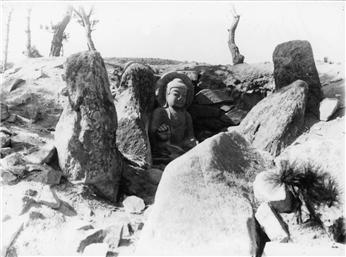전 삼화령
| 전 삼화령 Samhwaryeong Pass (Presumed) |
|
 최동진 기자, ⑤ 경주 남산 삼화령, 금강신문 2011년 10월 7일자 기사. |
|
| 대표명칭 | 전 삼화령 |
|---|---|
| 영문명칭 | Samhwaryeong Pass (Presumed) |
| 한자 | 傳 三花嶺 |
| 주소 | 경상북도 경주시 내남면 남산 |
|
|
|
해설문
국문
삼화령은 `삼화수리'라고도 하는데, 수리는 높은 곳을 의미한다. 이곳은 1925년 국립경주박물관으로 옮겨진 석조삼존불상(石造三尊佛像)이 출토된 곳이다.
『삼국유사』에 삼화령과 관련한 기록이 있다. 선덕여왕(재위 632~647) 때 생의(生義)라는 스님이 도중사(道中寺)에 거주하였다. 하루는 꿈에 한 스님이 그를 데리고 남산으로 올라가 풀을 묶어서 표시를 하게하고, 산의 남쪽 마을에 이르러서 말하길, "내가 이곳에 묻혀있으니, 꺼내어 고개 위에 안치해주시오.”라고 하였다. 잠에서 깬 후 산에 올라 표시해 둔 곳을 찾아 땅을 파보니 돌로 만든 미륵[石彌勒]이 나왔으므로, 삼화령 위에 안치하였다. 이후 그곳에 절을 짓고 생의사(生義寺)라 이름하였다. 또 경덕왕(재위 742~765) 때 충담사(忠談師)*가 3월 3일과 9월 9일에 삼화령의 미륵세존(彌勒世尊)에게 차 공양을 하였다고 한다.
이곳에서 출토된 석조삼존불상의 본존은 의자에 앉아 있는 의자상(倚子像)으로 일반적인 불상의 표현방식과는 전혀 다른 특이한 형식이다.
- 충담사(忠談師): 신라 경덕왕 때의 승려. 그가 지은 향가 ‘안민가(安民歌)’와 ‘찬기파랑가(讚耆婆郞歌)’가 『삼국유사』에 전한다.
영문
Samhwaryeong Pass (Presumed)
This site on Namsan Mountain is presumed to be the location of Samhwaryeong Pass, which is mentioned in the Memorabilia of the Three Kingdoms (Samguk yusa) written by the Buddhist monk Iryeon (1206-1289) in 1281.
It is said that during the reign of Queen Seondeok (r. 632-647) of the Silla kingdom (57 BCE-935 CE), there was a Buddhist monk named Saengui who lived at Dojungsa Temple. One day, a monk came to him in his dream and took him to Namsan Mountain. He marked a spot with some foliage and said, “I am buried here, so retrieve me and place me on top of the hill.” After waking up, Monk Saengui found the place marked in the dream and began digging up the ground. Buried at the spot was a stone statue of Maitreya, the Future Buddha. He enshrined the Buddha atop Samhwaryeong Pass, and later founded a temple there named Saenguisa. It is also said that during the reign of King Gyeongdeok (r. 742-765), an offering was made to Maitreya on Samhwaryeong Pass twice a year.
In 1925, a stone Maitreya Buddha triad was recovered from this site that is presumed to date to the 7th century. It is currently exhibited at the Gyeongju National Museum and was designated as a Treasure in 2020. The principal buddha of the triad is depicted seated on a chair rather than a pedestal, which is rare in Korea.
